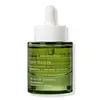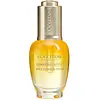What's inside
What's inside
 Key Ingredients
Key Ingredients

 Benefits
Benefits

 Concerns
Concerns

 Ingredients Side-by-side
Ingredients Side-by-side

C13-15 Alkane
SolventCocoglycerides
EmollientOctyldodecanol
EmollientIsoamyl Laurate
EmollientCoco-Caprylate
EmollientHydrogenated Ethylhexyl Olivate
EmollientAlcohol Denat.
AntimicrobialCrambe Abyssinica Seed Oil
Skin ConditioningOlea Europaea Fruit Oil
MaskingVitis Vinifera Fruit Extract
Skin ConditioningWater
Skin ConditioningAscorbyl Tetraisopalmitate
AntioxidantEthyl Linoleate
EmollientEthyl Linolenate
EmollientEthyl Oleate
EmollientEthyl Palmitate
EmollientEthyl Stearate
EmollientGlycerin
HumectantHelianthus Annuus Seed Oil
EmollientHydrogenated Olive Oil Unsaponifiables
EmollientLactic Acid
BufferingLecithin
EmollientResveratrol
AntioxidantTocopherol
AntioxidantTocopheryl Acetate
AntioxidantVitis Vinifera Seed Oil
EmollientPotassium Sorbate
PreservativeSodium Benzoate
MaskingParfum
MaskingC13-15 Alkane, Cocoglycerides, Octyldodecanol, Isoamyl Laurate, Coco-Caprylate, Hydrogenated Ethylhexyl Olivate, Alcohol Denat., Crambe Abyssinica Seed Oil, Olea Europaea Fruit Oil, Vitis Vinifera Fruit Extract, Water, Ascorbyl Tetraisopalmitate, Ethyl Linoleate, Ethyl Linolenate, Ethyl Oleate, Ethyl Palmitate, Ethyl Stearate, Glycerin, Helianthus Annuus Seed Oil, Hydrogenated Olive Oil Unsaponifiables, Lactic Acid, Lecithin, Resveratrol, Tocopherol, Tocopheryl Acetate, Vitis Vinifera Seed Oil, Potassium Sorbate, Sodium Benzoate, Parfum
Caprylic/Capric Triglyceride
MaskingHelianthus Annuus Seed Oil
EmollientOctyldodecanol
EmollientCoco-Caprylate/Caprate
EmollientSqualane
EmollientBorago Officinalis Seed Oil
EmollientHelichrysum Italicum Extract
AntiseborrhoeicHelichrysum Italicum Flower Oil
MaskingPrunus Armeniaca Kernel Oil
MaskingOenothera Biennis Oil
EmollientRosa Moschata Seed Oil
EmollientMyrtus Communis Oil
MaskingHippophae Rhamnoides Oil
EmollientCamelina Sativa Seed Oil
Skin ConditioningPelargonium Graveolens Oil
MaskingCitrus Aurantium Dulcis Oil
MaskingEchium Plantagineum Seed Oil
Skin ConditioningTocopherol
AntioxidantParfum
MaskingLimonene
PerfumingLinalool
PerfumingGeraniol
PerfumingCitronellol
PerfumingCitral
PerfumingCaprylic/Capric Triglyceride, Helianthus Annuus Seed Oil, Octyldodecanol, Coco-Caprylate/Caprate, Squalane, Borago Officinalis Seed Oil, Helichrysum Italicum Extract, Helichrysum Italicum Flower Oil, Prunus Armeniaca Kernel Oil, Oenothera Biennis Oil, Rosa Moschata Seed Oil, Myrtus Communis Oil, Hippophae Rhamnoides Oil, Camelina Sativa Seed Oil, Pelargonium Graveolens Oil, Citrus Aurantium Dulcis Oil, Echium Plantagineum Seed Oil, Tocopherol, Parfum, Limonene, Linalool, Geraniol, Citronellol, Citral
 Reviews
Reviews

Ingredients Explained
These ingredients are found in both products.
Ingredients higher up in an ingredient list are typically present in a larger amount.
Helianthus Annuus Seed Oil is the oil derived from the seeds of a Sunflower. Sunflower seed oil is non-fragrant. It is an emollient, meaning it helps to soften the skin.
Sunflower seed oil contains many fatty acids. The fatty acids found in sunflower seeds include (from highest amount to least): linoleic acid, myristic acid, palmitic acid, stearic acid, arachidic acid, oleic acid, and linolenic acid.
These fatty acids help the skin create ceramides. Ceramides play a role in repairing the skin barrier.
Helianthus Annuus Seed Oil helps moisturize the skin. This in turn helps the skin look more rejuvenated and smoother.
Sunflowers are rich in vitamin E.
Historians believe Indigenous cultures of North America domesticated sunflowers before corn. Thus they relied on sunflower oil for a variety of uses. One such use is moisturizing skin and hair.
Sunflower seed oil may not be fungal acne safe. We recommend speaking with a professional if you have any concerns.
Learn more about Helianthus Annuus Seed OilOctyldodecanol is a fatty alcohol. It is primarily used to enhance the texture of products.
As an emulsifier, Octyldodecanol helps prevent the oils and waters from separating. It also prevents ingredients from creating foam when shaken.
Octyldodecanol is created by reducing fatty acid to an alcohol.
Due to its high molecular weight, it does not get absorbed into the skin.
Learn more about OctyldodecanolParfum is a catch-all term for an ingredient or more that is used to give a scent to products.
Also called "fragrance", this ingredient can be a blend of hundreds of chemicals or plant oils. This means every product with "fragrance" or "parfum" in the ingredients list is a different mixture.
For instance, Habanolide is a proprietary trade name for a specific aroma chemical. When used as a fragrance ingredient in cosmetics, most aroma chemicals fall under the broad labeling category of “FRAGRANCE” or “PARFUM” according to EU and US regulations.
The term 'parfum' or 'fragrance' is not regulated in many countries. In many cases, it is up to the brand to define this term.
For instance, many brands choose to label themselves as "fragrance-free" because they are not using synthetic fragrances. However, their products may still contain ingredients such as essential oils that are considered a fragrance by INCI standards.
One example is Calendula flower extract. Calendula is an essential oil that still imparts a scent or 'fragrance'.
Depending on the blend, the ingredients in the mixture can cause allergies and sensitivities on the skin. Some ingredients that are known EU allergens include linalool and citronellol.
Parfum can also be used to mask or cover an unpleasant scent.
The bottom line is: not all fragrances/parfum/ingredients are created equally. If you are worried about fragrances, we recommend taking a closer look at an ingredient. And of course, we always recommend speaking with a professional.
Learn more about ParfumTocopherol (also known as Vitamin E) is a common antioxidant used to help protect the skin from free-radicals and strengthen the skin barrier. It's also fat soluble - this means our skin is great at absorbing it.
Vitamin E also helps keep your natural skin lipids healthy. Your lipid skin barrier naturally consists of lipids, ceramides, and fatty acids. Vitamin E offers extra protection for your skin’s lipid barrier, keeping your skin healthy and nourished.
Another benefit is a bit of UV protection. Vitamin E helps reduce the damage caused by UVB rays. (It should not replace your sunscreen). Combining it with Vitamin C can decrease sunburned cells and hyperpigmentation after UV exposure.
You might have noticed Vitamin E + C often paired together. This is because it is great at stabilizing Vitamin C. Using the two together helps increase the effectiveness of both ingredients.
There are often claims that Vitamin E can reduce/prevent scarring, but these claims haven't been confirmed by scientific research.
Learn more about Tocopherol